Now that 10-PW peak power laser systems are within reach, systems designers consider 100.
HANK HOGAN, CONTRIBUTING EDITOR
In Europe, China, and the U.S., laser projects — either built or planned — are ramping up intensity, with systems now reaching peak power of 10 petawatts (PW), or 10 million billion watts. On the drawing boards are lasers that will crack 100 PW peak power, which is high enough to create matter and antimatter from empty space.
Proving Einstein’s famous theory
E = mc2 with lasers in this way will not be easy, but it appears doable, said Allen Weeks, director general of the ELI
(Extreme Light Infrastructure) Delivery
Consortium. This EU project is an inter-
national laser research initiative with high-intensity laser facilities in Romania,
Hungary, and the Czech Republic. Differing in capabilities and intended uses, these facilities now are engaged in scientific research. They’ll be fully commissioned at the end of 2022.
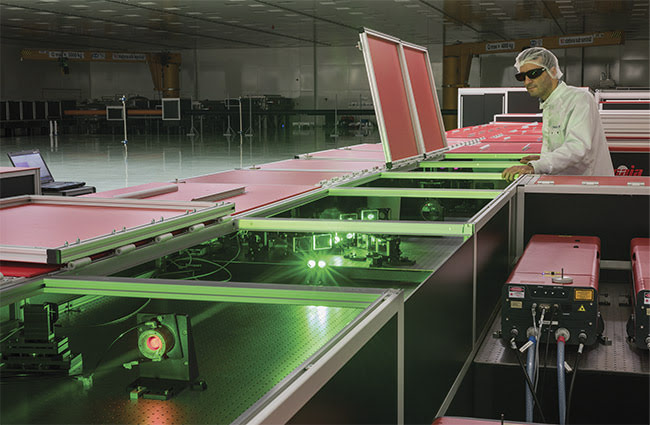
The ELI laser in Romania will deliver one shot per minute at 10 PW (10 million billion watts). Lasers at other ELI facilities in the Czech Republic and Hungary will produce 10 pulses per secondcat petawatt and higher rep rates, at lower intensities. Courtesy of Thales Group.
ELI’s goals include someday building a 100-PW-class laser, but the consortium is not focused on a technological demonstration of high-peak powers, said Weeks.
“The aim is to have robust, reliable lasers, with significantly higher repetition rates at PW [levels], with high repetition so that we can operate and provide access to scientific users, much as a synchrotron does.”
Elaborating on the meaning of this, Weeks said the aim is to provide at least one shot per minute at the 10-PW level, 10 pulses per second at petawatt intensity, and even higher repetition rates at lower power levels. Previous state-of-the art was one pulse per hour for a 1- to 3-PW system, he said.
A higher rep rate means that scientists can run more experiments in shorter periods of time. Generating more pulses in less time speeds up fundamental research into matter and light-matter interactions.
A pulse rate significantly higher than 10 shots per second would make practical a new type of particle accelerator, one that uses a plasma wave instead of traditional radio waves to push protons and electrons
to higher and higher speeds. A key advantage of the laser-based method is that it can achieve much higher particle acceleration in a much more compact form. Instead of sprawling over tens of miles, laser wakefield accelerators would provide an option that is orders of magnitude smaller.
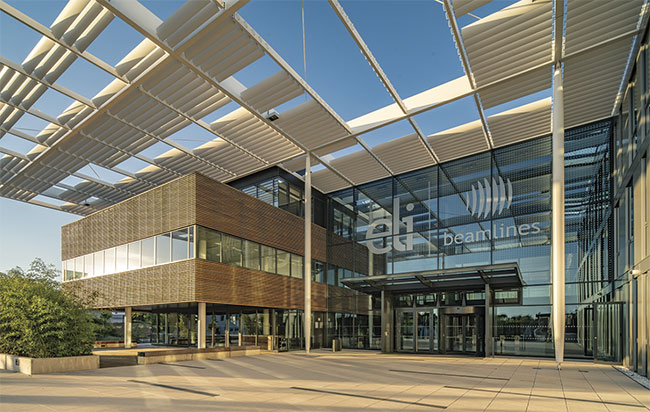
The ELI Beamlines building in Dolní Brežany, Czech Republic. ELI has some of the highest-intensity lasers in the world at three different beamlines. Courtesy of ELI.
To be as small as possible, a wakefield accelerator needs both high peak power and a high rep rate. This combination translates into a high average power and helps to establish a powerful wave in the plasma that carries along charged particles, much like a surfer riding an ocean wave.
“You need more reliable, continuous power to be able to drive these wakefield accelerators well,” said Weeks.
It is unclear how much higher the repetition rate needs to be. François Lureau, laser project manager in the Thales Group, predicted that it likely needs to be in the range of 100 to 1000 shots per second. The Paris-based company built the 10-PW laser system located at the ELI facility in Magurele, Romania. The company has also designed and constructed a number of other high-intensity lasers, including the Lawrence Berkeley National Laboratory petawatt laser that has been in place for about 10 years.
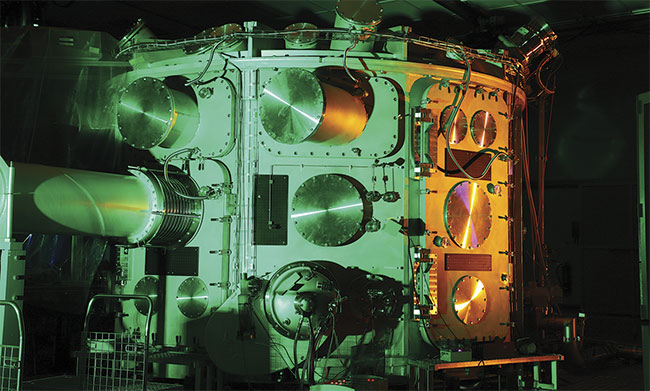
The E3 experimental station at ELI Beamlines. Its plasma physics platform enables up to five synchronized lasers to collide their beams on a target, with petawatt intensity. Courtesy of ELI.
Chirped pulse amplification
High-intensity lasers around the world are built using chirped pulse amplification, a concept that led to the 2018 Nobel Prize in physics for Donna Strickland and Gérard Mourou. Mourou is a driving force behind ELI.
Chirped pulse amplification starts with a pulse of pedestrian power and can finish with one in the petawatt level. The initial pulse is femtoseconds in duration, and it is stretched out to about a nanosecond, thereby approaching a million-fold elongation. The pulse is also spectrally widened and spatially broadened so that it covers more bandwidth and a larger area. The stretched pulse is sent through a Ti:sapphire crystal that has been pumped into an excited state by a laser. The energy stored in the crystal goes into the pulse, with this amplification repeated as needed by sending the pulse through successive crystals.
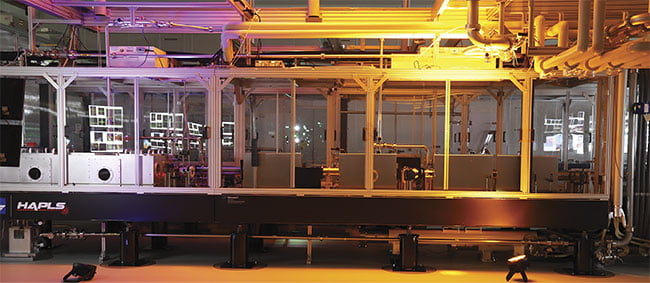
The L3, or HAPLS (High-Repetition-Rate Advanced Petawatt Laser System), laser at ELI Beamlines (right). Built together with the laser at Lawrence Livermore National Lab, it is one of the world’s most powerful lasers, producing petawatt pulses of light at 10 Hz. Courtesy of ELI.
The pulse is then optically compressed again, so that it is only tens of femtoseconds long and again spectrally compact. The resulting pulse can pack a punch — 10 PW of power in the case of ELI’s Romanian facility.
According to Lureau, building such
lasers required innovations in several areas. Thales developed a 14-joule green pump laser for the Berkeley facility. Getting to 10 PW required improvements in that component.
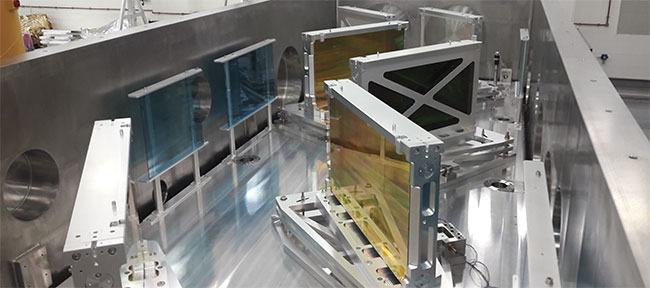
The ELI-NP optical pulse compressor with meter-sized gratings, which can produce a pulse of 10-PW peak power (below). In a chirped pulse amplification laser, after going through several stages of amplification, a pulse is compressed in time from about a nanosecond to tens of femtoseconds duration, increasing peak power. Courtesy of Thales Group.
“We needed to have a pump laser able to deliver 100 joules,” Lureau said.
Thales also added two more stretched pulse amplification stages, bringing the total to five. The combination of a seven-fold increase in pump power and a roughly 40% increase in amplification enabled the system to produce a pulse that was 10× more powerful than was possible with a state-of-the-art system a decade prior.
It may seem that this same formula could be used to reach the next milestone, the 100-PW laser. Lureau pointed out, however, that certain constraints will likely keep this from happening.
Chief among them are thermal considerations and material limitations. As the beam travels through the crystals and bounces off the optics in the system, the beam leaves behind heat. If the heat can’t be dissipated, it will exceed a critical limit and damage components. The beam can be made broad enough to avoid this problem, but then the amplifying crystals and all the optics have to be large enough to accommodate the broad beam.
This requirement presents problems. For instance, the Ti:sapphire crystal in the 10-PW laser measures 200 mm, a size that had never been achieved before, Lureau said. The sapphire material group GT Advanced Technologies of Salem, Mass., supplied the sapphire crystals, but at present, the ability to manufacture the larger crystals needed for a 100-PW system is uncertain.
As for the other optical components, the gratings that help to compress the beam at the end measure more than a meter, in a vacuum chamber that’s the size of a car. Producing the larger optics needed for a 100-PW system may prove too difficult.
“When you increase the energy, you have to manage thermal effects, not only in your pump laser but also your components. It’s a balance between peak power and repetition rate,” Lureau said.
Thus, improved thermal management could enable higher average or peak power. One improvement may be to use helium or some other form of active cooling to dissipate heat. Such an approach, though, could prove costly. Increased efficiency in turning input power into laser output could also help lower the overall heat load.
Aside from better thermal management, one way to increase the peak power might be to further compress the final output pulse. So, instead of being 20 to 40 fs long, the pulse may be only 10 fs or less. This would double or quadruple the peak power.
There is also the possibility of coherently combining several beams. This approach is reportedly being pursued by researchers in Shanghai, in what is known as the Station of Extreme Light (SEL), which is scheduled for completion within the next three years or so. The SEL will consist of four 25-PW lasers coherently combined into a 100-PW beam. The approach requires precisely managing the manufacture and operation of optical components.
The various technologies developed to reach such high peak power may find their way into less demanding research use and even commercial applications. If this happens, it will likely be at lower power levels, according to Jonathan Zuegel, a senior scientist at the University of Rochester’s Laboratory for Laser Energetics. The laboratory has proposed building two 25-PW laser beamlines, a concept that has garnered support among the high-intensity laser community. However, this project has not yet been funded.
In some fundamental research, he noted, the goal is to achieve the highest possible power. Maximizing peak power typically leads to a lower repetition rate and more downtime, a consequence of pushing components to their limits.
Zuegel said about lasers, “They’re physical objects and they wear out.”
He added that increased uptime — a necessity for industrial use — requires a change in approach. “If you want to run a laser like a car, where you run it for 5000 miles and then you change the oil, you have to design it differently.”
New ways to achieve greater reliability in components and increased uptime in systems may come after a proof of principle that demonstrates a laser intensity milestone. Knowing what’s needed for a 100-PW laser, for example, could allow scientists and engineers to devise improved, more robust solutions that would benefit lower-intensity lasers and make them more commercially viable.
ELI’s Weeks said a laser that’s powerful enough to create matter out of energy would enable fundamental and exotic science. However, the industry will not come up with such a laser and its components on its own because there’s no market and no reason to pay for development costs. This is where facilities such as national labs and ELI could potentially play roles to finance the development of technology that industry could then commercialize.
“Once they [industry] have the technology in a lab like ELI, then they roll it out,” said Weeks.